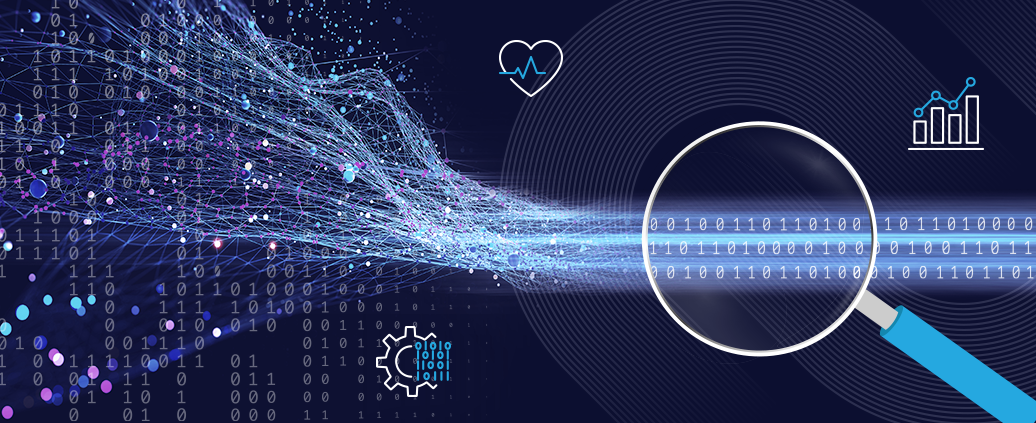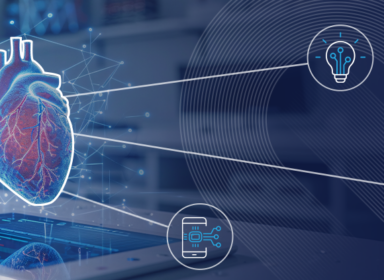The healthcare industry is grappling with a data volume crisis, seen everywhere from the patient bedside to the surgical suite and beyond. Cardiology, in particular, generates unprecedented amounts of data from patient monitoring, both inside and outside the hospital. And the volume of clinical data continues to grow.
Modern diagnostic tools like next-generation remote patient monitoring (RPM) and high-resolution imaging provide more granular diagnostics, resulting in even larger datasets. More information is always better—but without the right tools, a glut of data can also contribute to fragmentation and silos, making it difficult to integrate and interpret valuable information effectively. According to one study, healthcare data is projected to grow at a CAGR of 36% through 2025—yet 80% of this data remains unstructured and underutilized.
This article explores how artificial intelligence (AI) can efficiently manage today’s data deluge, unearth meaningful insights, enhance diagnostic accuracy, and unleash a new era of efficient patient care. Virtual cardiac telemetry will serve as our example here, but the benefits of AI have the power to transform diagnostics profoundly and universally across many disciplines.
The Data Dilemma: Overcoming the Remote Patient Monitoring Data Glut with AI
Virtual cardiac telemetry remotely monitors a patient’s heart activity in near real-time. It involves the use of convenient wearable devices that record the electrical activity of the heart. Today’s virtual cardiac telemetry devices deliver more data than ever before, as they accompany the patient wherever they go and continuously deliver vast amounts of high-acuity health data to the provider. With this glut of data comes the critical need for efficient analysis and actionable insight. AI provides a ready answer.
AI algorithms can take the data collected from remote patient monitoring devices and analyze it by processing and filtering the raw data to eliminate irrelevant or redundant information. They then use machine learning models to identify patterns, trends, and anomalies within the data, such as irregular heartbeats (which are signs of arrhythmia) or unusual blood pressure levels. The algorithms also compare current data against historical data to detect significant changes and predict potential health issues.
These valuable insights are then presented to cardiologists and other clinicians in an actionable format, like dashboards and programmed alerts, which enable them to make informed decisions, initiate timely interventions, and personalize patient care plans based on near real-time, data-driven insights.
AI-enabled analytics not only solve the data volume challenge presented by high-acuity remote cardiac monitoring, but they also raise the bar for detection and diagnostic accuracy beyond what is possible with a human reviewer alone. Let’s take a closer look at how AI-enabled analysis improves diagnostics.
Five Ways AI Enhances Diagnostics
AI unleashes a multitude of benefits, but at its core, its true value is in transforming massive datasets into instant insights. What was previously arduous work for a human data analyst is easy for AI—whose capacity continues to scale upward in commensuration with its computing power. When applied to healthcare diagnostics, AI’s transformative benefits can be summarized in five key enhancements.
- Timeliness
Because of AI’s ability to quickly and efficiently analyze data and deliver insights to clinicians, one of its chief benefits is the timeliness with which it enables diagnosis. Diagnostic timeliness has the potential to dramatically improve patient outcomes by preventing delays that may result in complications or death. This is even more critical in the cardiac specialty, where conditions are often only diagnosed once they progress. By contrast, AI can help diagnose a patient before symptoms even arise by identifying even the subtlest anomalies in their heart rhythms. - Personalization of Care
Studies suggest that the personalization of cardiac care has the potential to be truly transformative, particularly given the uniqueness of each patient’s heartbeat. By discerning the subtle variations of each patient’s cardiac data and comparing data across populations, AI enables cardiologists to develop more tailored care plans and pursue truly personalized care. The vast benefits of personalized medicine include improved diagnostic accuracy, better treatment options, more targeted therapy, reduced side effects, more effective disease prevention, increased patient engagement, reduced healthcare costs, and better outcomes. - Expanded Indicators
In traditional cardiac diagnostics, primary indicators include heart rate and rhythm, ECG alterations, heart rate variability, and specific cardiac events. AI can expand this list to eventually include new indicators, like subtle or complex arrhythmias, stress and recovery metrics, subclinical conditions, early warning signs, and even predictive analytics. These advanced analytical techniques allow providers to assess patient risk more precisely and tailor care plans accordingly, moving cardiology towards more optimized treatments and better clinical decision-making. - Continuous Improvement
Today’s standard of care doesn’t fully prevent cardiac deaths, so continuous improvement is required to mitigate the public health crisis of rising cardiac events. Continuous learning and improvement are central characteristics of AI, which continues to enhance diagnostic accuracy and precision over time. AI can also facilitate the integration of data from disparate sources, breaking down data silos and enabling clinicians to see the whole picture. AI suggests that the current standard of care will continue to improve, moving us closer to the aspirational goal of zero avoidable cardiac deaths. - Cost Efficiency
AI-powered RPM can dramatically reduce healthcare costs, as it enables more efficient workflows, faster interventions, and time savings. One report estimates that utilizing RPM can provide an annual savings of $1,054 to $1,950 per patient, and when applied across the national population, this could amount to $5.4 to $9.9 billion saved annually. Collectively, AI could save the U.S. up to $360 billion annually if adopted more widely in healthcare.
AI-Enabled Diagnostics Enable the New Standard of Care
The integration of AI into healthcare diagnostics, particularly through remote patient monitoring devices, marks a pivotal shift in the industry. By converting the overwhelming influx of data into actionable insights without additional costs or clinical burden, AI not only enhances diagnostic precision but also streamlines patient care. As we’ve seen with virtual cardiac telemetry, AI’s ability to analyze and interpret vast amounts of data in near real-time is redefining the way healthcare providers approach diagnostics, offering a clearer path to better patient outcomes.
As the volume of healthcare data continues to grow, the role of AI in managing this information will become increasingly critical. Transforming the data deluge to diagnostic clarity is not just a remote possibility—it is a tangible reality that is already transforming patient care.
The future of healthcare is one where AI-driven insights will be central to delivering timely, accurate, and personalized care, ensuring that every heartbeat, scan, and test result is leveraged to its fullest potential. InfoBionic.Ai is leading the way towards making this a possibility with our MoMe ARC®—an innovative virtual cardiac telemetry solution that enables providers to more effectively monitor their patients from nearly anywhere at any time, empowering better patient care.
Contact us today to learn how InfoBionic.Ai’s AI-enabled virtual cardiac telemetry solution is helping shape the new standard of cardiac care.


